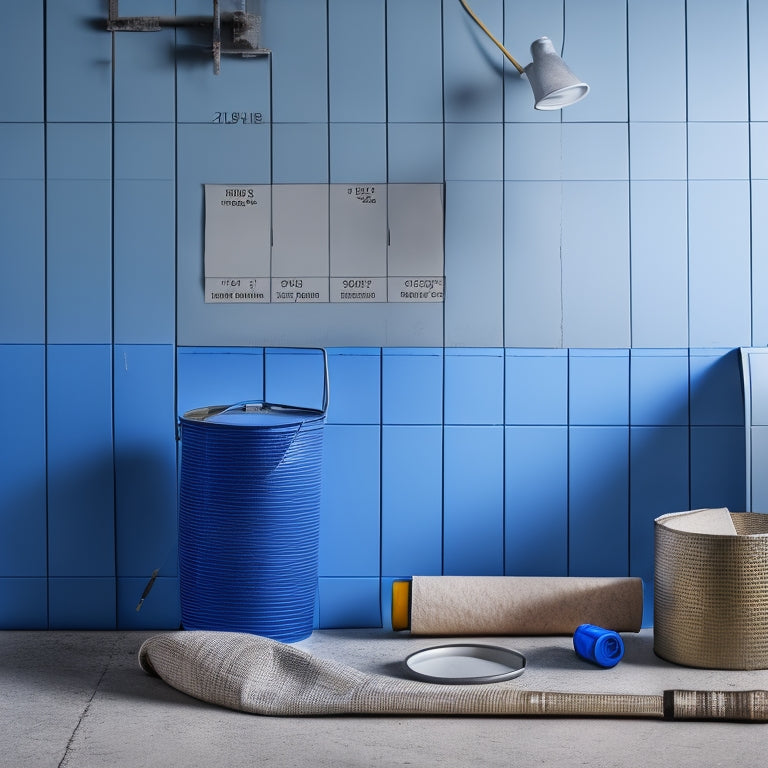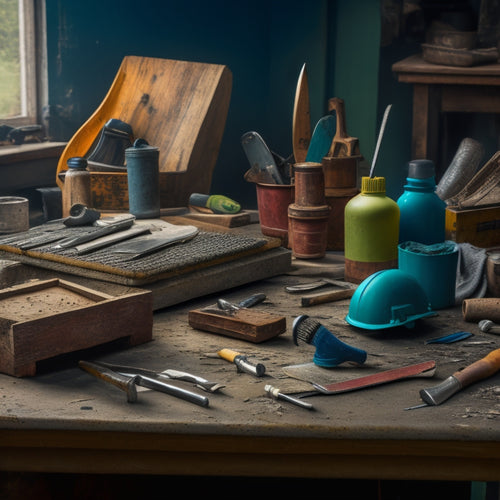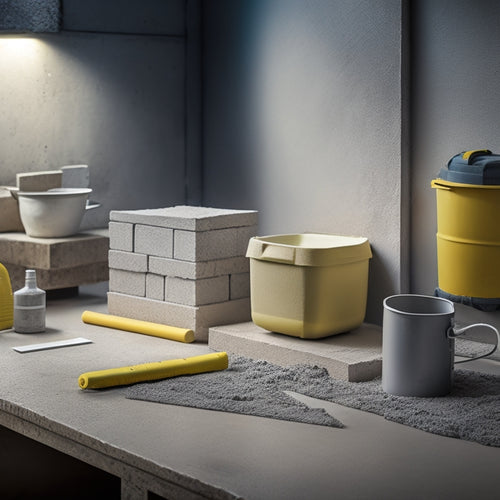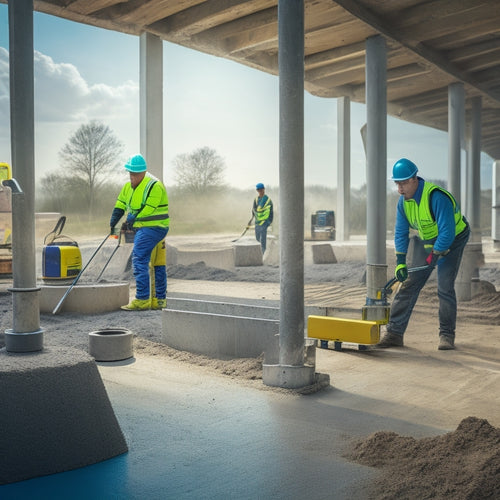
Estimate Concrete Wall Painting Costs With These Tools
Share
You can accurately estimate concrete wall painting costs by leveraging a combination of online tools, DIY calculation worksheets, and precise measurement techniques that consider factors like wall dimensions, paint finish options, surface preparation, and local labor rates. Use concrete paint calculators to get instant estimates, or apps like Behr and Sherwin-Williams' Paint Calculators to determine paint quantities. DIY worksheets help you calculate labor costs and surface areas. Accurately measuring your wall's surface area and factoring in local labor rates will give you a thorough estimate. By utilizing these tools, you'll be well on your way to creating a detailed and reliable budget for your project, and with a little more exploration, you'll be able to refine your estimate even further.
Key Takeaways
• Online concrete paint calculators provide instant estimates based on project details like wall dimensions and paint finish options.
• Paint quantity estimator apps help prevent running out of paint or wasting money on excess paint by calculating precise amounts.
• DIY calculation worksheets help calculate paint quantity needed and determine labor costs accurately by breaking down tasks and assigning time durations.
• Concrete surface area calculators ensure accurate total square footage calculations by considering wall dimensions, obstructions, and painting techniques.
• Total project cost analyzers combine paint material costs with labor and equipment fees to provide a comprehensive view of total project costs.
Online Concrete Paint Calculators
You can quickly determine your concrete wall painting project's material and labor costs using online concrete paint calculators, which provide instant estimates based on your specific project details.
These calculators typically require you to input the wall's dimensions, paint finish options, and surface preparation techniques. By doing so, you'll get a precise estimate of the materials needed, including the quantity of paint, primer, and other supplies.
Furthermore, you'll also get an estimate of the labor costs, which will depend on the complexity of the project, the number of coats required, and the local labor rates. With this information, you can create a thorough budget plan, guaranteeing you stay within your means and avoid costly surprises.
To guarantee a safe and successful project, it's crucial to evaluate factors like surface preparation, which may involve power washing, patching, or applying a bonding agent.
DIY Estimation Worksheet Tools
When estimating concrete wall painting costs on your own, you'll need to accurately calculate the paint quantity required, determine labor costs precisely, and select the right painting tools for the job.
To do this, you can utilize DIY estimation worksheet tools that guide you through these critical steps.
Calculate Paint Quantity Needed
The surface area of the concrete wall, in square feet, must be calculated to determine the quantity of paint required. To do this, measure the length and width of each wall section, and multiply these values to get the area. Don't forget to subtract any areas that won't be painted, such as windows or doors.
Next, consider the type of paint you'll be using. Different paint types have varying coverage rates, which affect how much paint you'll need. For example, primer-paint combos typically cover about 300-400 square feet per gallon, while epoxy paints may cover only 200-250 square feet per gallon.
Proper surface preparation also impacts paint quantity. If the wall has a rough, porous surface, you may need more paint to achieve satisfactory coverage. On the other hand, a smooth surface will require less paint.
Be sure to factor in these variables when calculating your paint needs. By doing so, you'll guarantee a safe and successful painting project.
Determine Labor Costs Accurately
Estimating labor costs accurately requires breaking down the painting project into tasks and assigning a time duration to each, factoring in your level of expertise and the complexity of the job. You'll need to identify the specific activities involved, such as surface preparation, primer application, and paint application. For each task, estimate the time required to complete it, considering factors like the wall's size, surface condition, and the number of coats needed.
To refine your estimate, consider labor cost factors like your hourly wage, the number of workers involved, and any additional labor costs for equipment operation or material handling.
You can use estimating techniques like the 'three-point estimate' method, which involves calculating the most optimistic, pessimistic, and most likely time durations for each task. This approach helps you account for uncertainties and arrive at a more realistic labor cost estimate.
Select Right Painting Tools
You'll need to assemble a set of painting tools tailored to your concrete wall project, including rollers, extension poles, and brushes, to guarantee efficient and effective paint application.
The right tools will help you master various painting techniques and make certain a smooth surface preparation. For instance, a high-quality roller with the correct nap length will help you achieve an even coat, while a sturdy extension pole will allow you to reach high areas safely.
Don't forget to include a variety of brushes in your arsenal, as they're essential for cutting in and painting corners. When selecting brushes, consider the type of paint you're using and the surface texture of your concrete wall. A natural bristle brush is ideal for oil-based paints, while a synthetic brush is better suited for water-based paints.
Remember to choose tools that fit comfortably in your hand and are easy to maneuver, making certain a safe and successful painting experience.
Concrete Surface Area Calculators
When calculating the cost of painting your concrete wall, you'll need to determine its surface area.
To do this, you'll use a wall size calculator or a square footage estimator, which will give you an accurate measurement in square feet.
Wall Size Calculator
Measure your wall's length, width, and height to calculate its surface area using a concrete surface area calculator, which gives you the total square footage that needs painting. This is essential in determining the amount of paint and materials you'll need, making sure you don't run out mid-project.
To get accurate results, verify you take precise measurements of your wall dimensions, including any obstructions or cutouts. A wall size calculator will then convert these measurements into square feet, giving you the total surface area to be painted.
When using a wall size calculator, consider the painting techniques you'll employ. Will you be using a roller or brush? Different techniques require varying amounts of paint and materials. By factoring in your chosen technique, you can get a more accurate estimate of the materials needed.
This attention to detail will help you avoid costly mistakes and guarantee a safe, successful painting project. With the total square footage in hand, you can confidently move forward with your project, knowing you have the right amount of materials to get the job done safely and efficiently.
Square Footage Estimator
A concrete surface area calculator, also known as a square footage estimator, provides an exact calculation of your wall's surface area in square feet, guaranteeing you purchase the right amount of paint and materials for the job.
This tool is essential in determining the square footage importance, as it directly affects the overall cost of the project. You'll need to input the length, width, and height of your wall to get an accurate calculation.
The estimation accuracy is paramount, as it prevents you from under or overestimating the materials needed, which can lead to safety hazards and additional expenses.
With a square footage estimator, you can confidently calculate the surface area of your wall, taking into account any obstructions, cutouts, or irregular shapes. This precise calculation will give you a clear understanding of the materials required, guaranteeing you're prepared for a successful and safe painting project.
Paint Quantity Estimator Apps
You can accurately determine the amount of paint required for your concrete wall project using specialized paint quantity estimator apps that calculate the surface area and account for factors like porosity and texture. These apps guarantee you don't run out of paint mid-project or waste money on excess paint.
Here are some top paint quantity estimator apps to evaluate:
-
Paint Calculator by Behr: This app allows you to input your wall's dimensions and surface type to get an accurate estimate of paint needed.
-
Sherwin-Williams' Paint Calculator: This app takes into account the color and finish you choose, guaranteeing you get the right amount of paint for your project.
-
HomeRight Paint Calculator: This app offers a built-in surface area calculator and allows you to adjust for different paint coverage rates.
-
Dunn-Edwards Paint Calculator: This app provides a detailed estimate of paint needed, including primer and topcoat quantities.
-
Valspar Paint Calculator: This app offers a 'paint savings' feature, which suggests the most cost-effective paint options for your project.
When choosing an app, read user reviews and compare features to find the one that best fits your needs.
Local Labor Cost Checkers
Checking local labor costs is an important step in estimating concrete wall painting costs, as it helps you avoid under or overestimating the expense, ensuring a more accurate project budget.
You'll want to research local labor market trends to get an idea of the going rate for painters in your area. Online tools like HomeAdvisor's True Cost Guide or Thumbtack's Pricing Guide can give you a baseline estimate of labor costs based on your location.
Additionally, you can check with local painting contractors or construction companies to get quotes for your specific project. Be sure to factor in regional cost variations, as labor costs can differ greatly depending on the region, city, or even neighborhood.
For example, urban areas tend to have higher labor costs than rural areas. By accounting for these variations, you can create a more realistic project budget.
Paint Material Cost Estimators
Estimate paint material costs by calculating the quantity of paint required, considering factors like wall size, surface texture, and desired finish, to arrive at an accurate total material cost.
You'll need to determine the square footage of the wall, taking into account any obstacles or cutouts. Next, factor in the type and quality of paint you'll be using, as well as the number of coats you plan to apply.
Here are some essential considerations for estimating paint material costs:
-
Paint quality comparison: Research and compare prices of different paint brands and types to find the best value for your budget.
-
Surface preparation tips: Don't forget to factor in the cost of surface preparation materials, such as sandpaper, primer, and cleaning solutions.
-
Calculating paint quantity: Use a paint calculator or consult with a professional to ascertain you're ordering the right amount of paint for the job.
-
Additional materials: Remember to include the cost of rollers, brushes, and trays in your estimate.
-
Waste and overage: Always add 10-15% to your total material cost to account for unexpected waste and overage.
Total Project Cost Analyzers
With paint material costs calculated, the next step is to factor in labor costs, equipment rental fees, and other expenses to arrive at a thorough total project cost.
This is where total project cost analyzers come in. These tools help you estimate labor costs based on the complexity of the project, the number of coats required, and the surface area to be painted.
You'll also need to factor in equipment rental fees, such as scaffolding or lifts, and other expenses like masking film, drop cloths, and cleaning supplies.
Frequently Asked Questions
Can I Use Regular Paint on a Concrete Wall?
You're wondering if you can use regular paint on a concrete wall. The answer is, it's not recommended.
Regular paint won't adhere well to concrete, and the surface prep required is specific.
You'll need to use specialized paint types, like epoxy or acrylic, designed for concrete.
Confirm proper surface preparation, including cleaning, priming, and applying a concrete-specific bonding agent to guarantee a safe and durable finish.
Do I Need to Prime the Concrete Wall Before Painting?
You're wondering if you need to prime the concrete wall before painting. The truth is, priming is essential for a durable and long-lasting finish. Without it, paint may peel or flake off.
Proper concrete wall preparation involves applying a primer to create a bond between the concrete and paint.
Primer benefits include filling pores, reducing absorption, and guaranteeing a uniform finish. By priming, you'll secure a safe and successful painting project.
How Long Does It Take for Concrete Paint to Dry Completely?
When you apply concrete paint, you'll want to know how long it takes to dry completely. This depends on drying conditions and paint types.
In ideal conditions (70-80°F, 50-60% humidity), most acrylic and latex-based paints dry to the touch within 1-2 hours. However, it may take 24-48 hours for the paint to fully cure.
Make certain to follow the manufacturer's instructions and wait the recommended time before exposing the painted surface to heavy traffic or harsh weather conditions to guarantee a safe and durable finish.
Is It Necessary to Seal the Concrete Wall After Painting?
You're wondering if sealing the concrete wall after painting is necessary. The answer is yes, it's vital.
Sealing provides significant benefits, including moisture prevention, which is fundamental for maintaining the paint's integrity and preventing damage.
Without sealing, water can seep into the concrete, causing the paint to peel or flake off.
Can I Paint Over Existing Paint on a Concrete Wall?
When you're considering painting over existing paint on a concrete wall, you'll need to verify proper paint adhesion.
Start by evaluating the current paint's condition and adhesion. If it's peeling or flaking, you'll need to scrape it off and reapply a primer. Otherwise, lightly sand the surface to promote adhesion.
Next, perform thorough surface preparation, cleaning the wall of dirt, oil, or grease. This will guarantee a strong bond between the old and new paint, ensuring a safe and durable finish.
Conclusion
You've got the tools, now it's time to get to work!
With these concrete wall painting cost estimators, you're just a few calculations away from uncovering the total project cost.
Will it be a budget-friendly surprise or a wallet-busting shock?
The suspense is killing you, but the answer is just a click away.
Plug in the numbers, and get ready to reveal the final tally.
The fate of your project hangs in the balance - what'll the cost be?
Related Posts
-

Must-Have Handheld Tools for Concrete Repair
When tackling a concrete repair project, it is crucial to have the right handheld tools to achieve a professional fin...
-

What Tools Do I Need for Concrete Block Laying
You'll need a thorough set of tools to guarantee accurate, efficient, and professional concrete block laying. Essenti...
-

What Tools Ensure Precise Concrete Leveling Results
You need a range of specialized tools to achieve precise concrete leveling results. Laser leveling instruments provid...


